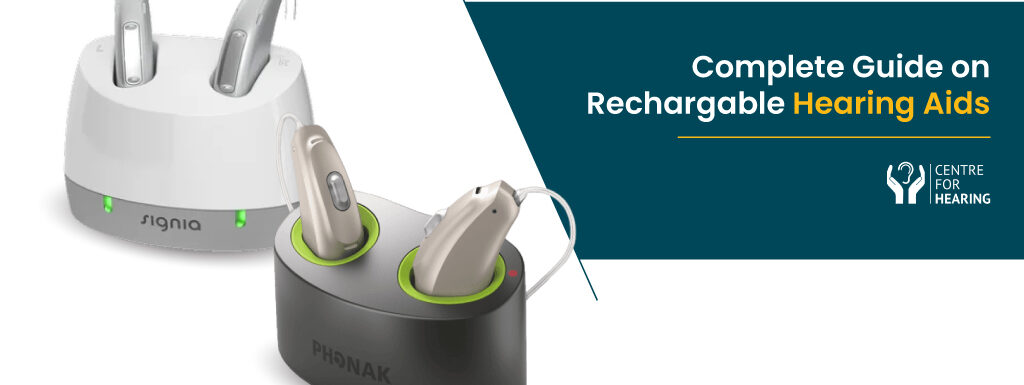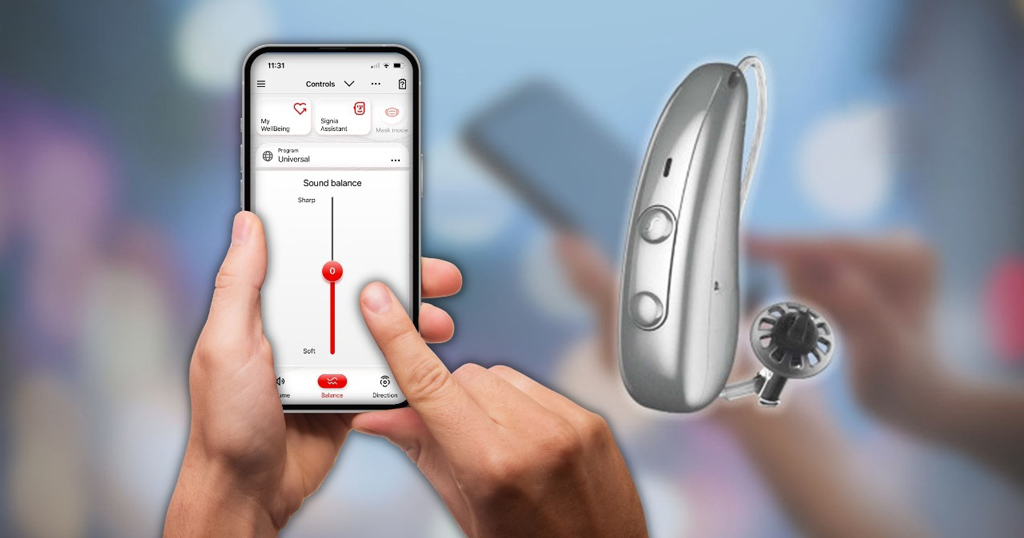Most traditional hearing aids have been using throw-away batteries as the default power source. For many users, it is a major pain point due to the recurring costs and the inconvenience of frequent replacements. Additionally, environmental concerns arise from the disposal of used batteries, which can contain harmful chemicals.
In response, modern rechargeable digital hearing aids have been developed as a simpler and more ecologically responsible alternative.
It is a huge leap forward in terms of size, technical features, and accessibility compared to traditional battery-powered devices.
Now, let’s look at some of its components and crucial factors to ensure you make informed decisions regarding your hearing health and purchase the best hearing care solution that fits your needs.
Why Opt for Rechargeable Digital Hearing Aids?
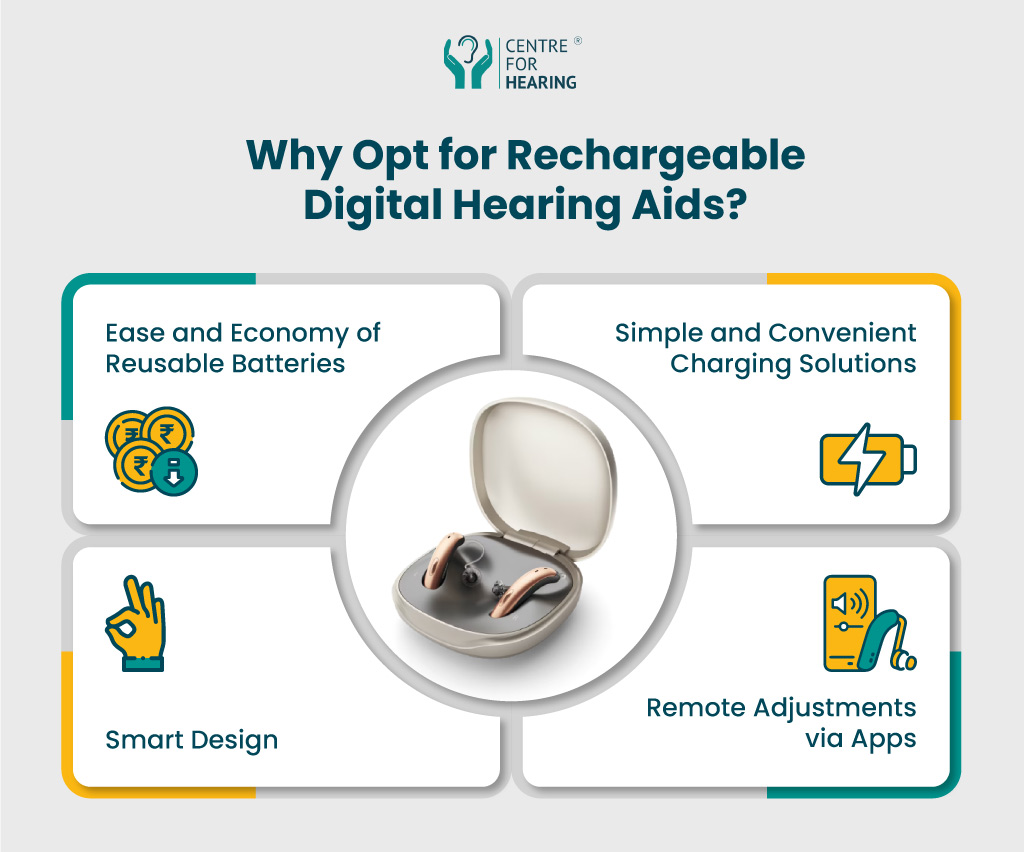
Rechargeable hearing aids stand out for their valuable features, including:
-
Ease and Convenience of Rechargeable Units:
The rechargeable design of these hearing aids eliminates the need for traditional batteries altogether. This frees users from the recurring costs and hassle of replacing disposable batteries. It also offers a more streamlined and cost-effective solution for hearing support.
-
Simple and Convenient Charging Solutions:
For rechargeable hearing aids, a micro USB connection or a charging station can be used. It’s as simple as charging your smartphone with zero hassles of looking for new batteries.
-
Smart Design:
Rechargeable hearing aids come integrated with cutting-edge technology and user-friendly design. They have features like Bluetooth connectivity, less weight, longer battery life and less environmental impact.
-
Remote Adjustments via Apps:
With the integration of smartphone apps, users of rechargeable hearing aids can conveniently adjust settings like volume and sound profiles from their devices.
Experience clarity like never before! Book your rechargeable hearing aid trial now. Click here to start your journey to better hearing!
What is the Difference Between Traditional and Rechargeable Digital Hearing Aids?
Compared to traditional hearing aids, rechargeable hearing aids dramatically changed the audiology market by providing consumers with a more contemporary and convenient alternative.
This shift reflects a more significant trend, with industry estimates indicating that rechargeable hearing aids may soon outnumber traditional devices in consumer appeal.
“At most professional clinics, we are seeing nearly 80-90% of the dispensed hearing aids being Rechargeable rather than Battery-operated.”
It is only in the lower-priced segment that we see people going for battery-operated instruments.
- Battery-operated digital hearing aid options start @ Rs.19,000 each (per ear) and upwards.
- Rechargeable digital hearing aid options start @ Rs.42,000 each (per ear)and upwards.
Check our latest Guide on Hearing Aid Prices for further details.

Pioneering this change was Phonak, which introduced rechargeable lithium-ion batteries, similar to those found in smartphones, offering a dependable power source for even the most ardent Bluetooth-enabled gadgets.
Subsequently, other major hearing aid brands followed suit, leveraging constant technological advancements to enhance battery life and enable more flexible and compact form factors. These upgrades improve the user experience overall and reflect the increasing inclination toward rechargeable hearing aids in line with modern lives.
4 Benefits of Rechargeable Digital Hearing Aids
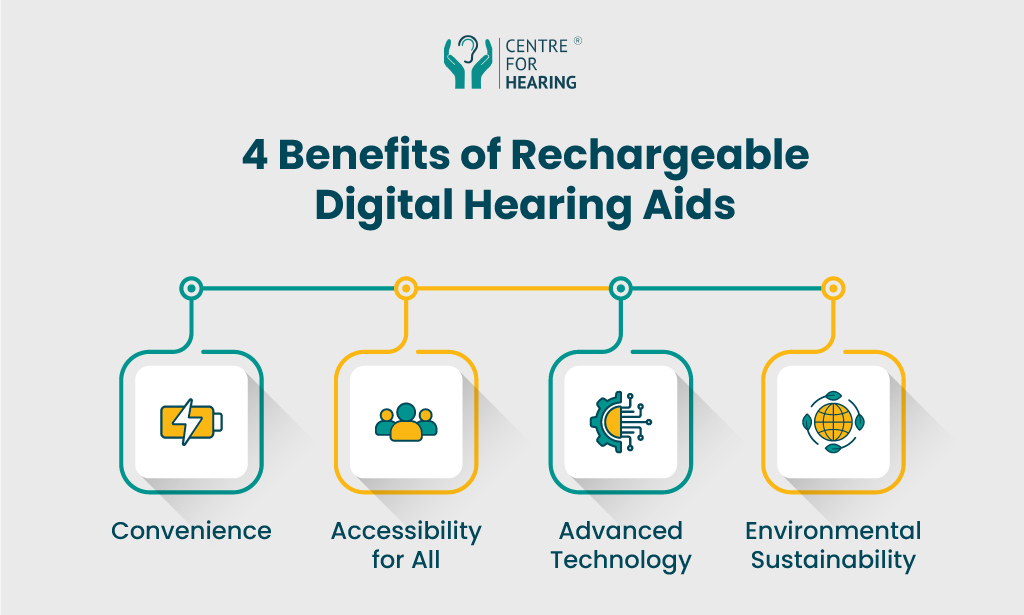
Now, let us assess some key advantages of rechargeable digital hearing aids:
1. Convenience
The fundamental appeal of rechargeable hearing aids is their ease of use. Users may charge their devices in a charging dock overnight to ensure they are ready to go in the morning, saving them from the hassle of messing with tiny throwaway batteries.
2. Accessibility for All
Individuals with different needs can benefit from rechargeable hearing aids. Handling small disposable batteries might be difficult for persons with poor vision or dexterity. Rechargeable batteries reduce this worry, making a more accessible alternative available to a wider range of customers.
3. Advanced Technology
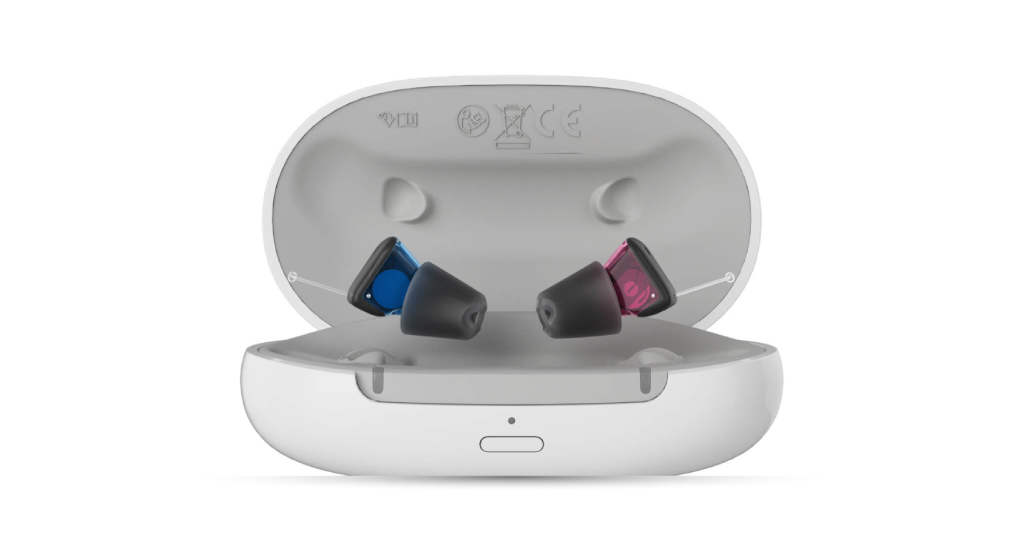
Modern features, including directional microphones, feedback reduction technology, and noise reduction, are included in the newest rechargeable hearing aids.
These supplementary characteristics, which guarantee focused and clear sound reception, improve the listening experience overall, particularly in demanding circumstances.
4. Environmental Sustainability
Regular batteries are difficult to recycle and harmful to the environment, while rechargeable batteries can be charged and used again and again. It’s this sociable lifestyle that contributes to environmental preservation.
Minor Drawbacks to Rechargeable Digital Hearing Aids
While rechargeable hearing aids offer numerous benefits, it’s essential to consider these potential drawbacks as well:
Cost
Rechargeable hearing aids tend to have a higher upfront cost compared to traditional battery-operated counterparts. Additional expenses may include the cost of the charging station and other accessories.
Limited Battery Life
Although battery technology has advanced, rechargeable hearing aids may still require regular recharging.
Considering Rechargeable Digital Hearing Aids?
For those contemplating the switch to rechargeable hearing aids, our consumer checklist provides essential considerations and questions to ask your audiologist:
1. Battery Life
Check the manufacturer’s estimated battery life to ensure it meets your daily hearing needs, including streaming requirements.
2. Charging Options
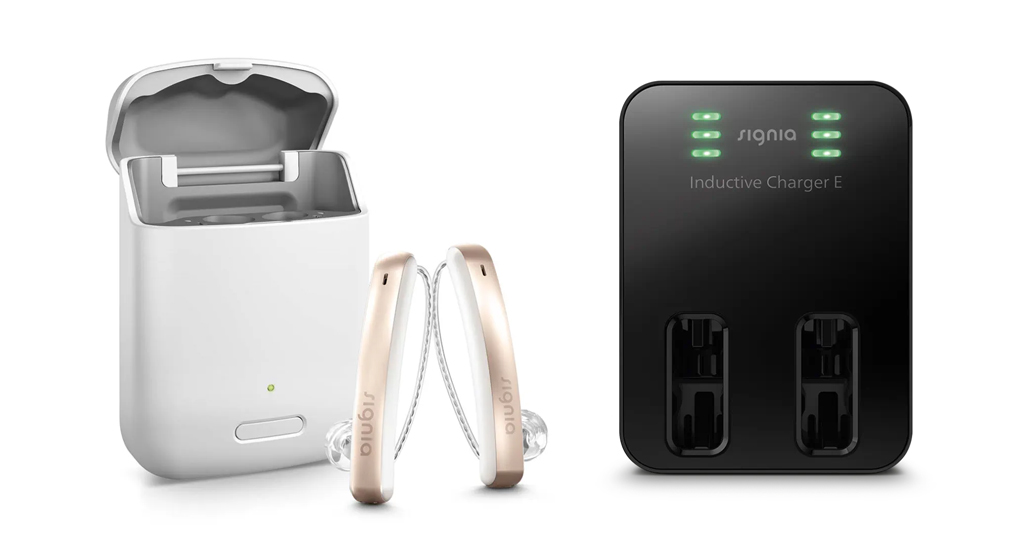
Understand the available charging options, whether through a charging system, charging case, or USB cable. Choose the one that is most suitable for your lifestyle.
3. Charging Time
Ask about the time it takes to charge the rechargeable digital hearing aids fully. Faster charging times can be advantageous, particularly for those with active lifestyles.
4. Power Management
Explore power-saving features and advanced power management systems to optimise battery usage throughout the day.
5. Compatibility
Ensure the rechargeable hearing aids are compatible with your level of hearing loss. Different models cater to varying hearing needs, emphasising the importance of finding the right fit.
6. Device Style and Fit
Consider the various sizes and styles of available rechargeable hearing aids.
Choose a style that aligns with your preferences, comfort, and any specific physical considerations.
7. Cost
Analyse the total expense, taking into account both the original purchase price and any necessary extra accessories. Examine the differences in long-term costs between rechargeable and disposable batteries.
8. Warranty and Support
Find out whether there is an aftercare program available and what warranty is offered by the manufacturer. A comprehensive support system provides a smooth voyage with your hearing aids.
Explore Improved Hearing: Rechargeable Digital Aids at Centre for Hearing®

Rechargeable digital hearing aids, which offer a plethora of benefits to users, are the consequence of improvements in hearing aid technology. While buying one, make sure your decision fits your interests and lifestyle by carefully weighing the benefits and potential negatives as you explore the variety of hearing solutions available.
For thorough assistance, consult our expert audiologists at Centre for Hearing® for expert advice geared to your specific requirements.
Centre for Hearing® possesses audiology and hearing aid centres in places such as Delhi, Gurgaon, Mumbai, the Chandigarh Tricity Area (Chandigarh – Mohali – Panchkula), and certain Punjab locations (Ludhiana – Patiala – Jalandhar).
Our dedication to internationally recognized hearing aid brands like Widex, Signia, Resound, Oticon, and Starkey ensures high-quality solutions with various pricing options.
Contact Centre for Hearing® right away to schedule your free consultation.
Locate a Hearing Aids Centre Near You:
